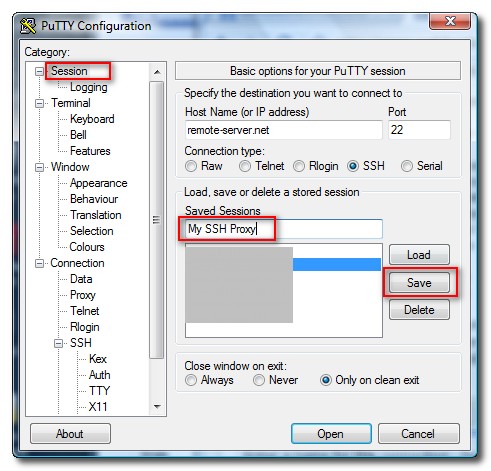

Go to and confirm that your IP address matches the host IP that you are tunneling through.Ģ.

Make sure 'SOCKS v5' is selected and select the 'OK' button to save.Īs long as your PuTTY SSH connection remains connected, your proxy tunnel will be open and you will be able to use the internet through this proxy.ġ. In the 'SOCKS Host' box enter 'localhost' and for 'Port' enter '31415' (or whatever you set your SSH Tunnel up with).ħ. Under 'Configure Proxies to Access the Internet' select the 'Manual proxy configuration' radio button.Ħ. Under Advanced, in the middle of the page, select Network -> Connection -> Settings.ĥ. On the left side of the window, select Advanced.Ĥ. Once the tunnel is established, you now need to set up a SOCKS proxy in your web browser.ģ. This should open and terminal window and you should be prompted to login. You should see 'D31415' in the 'Forwarded ports:' box.Ħ. Under 'Destination' select the 'Dynamic' radio button and leave the 'Auto' button selected.ĥ.

For 'Source Port' enter '31415' (this can be configured to whatever you want, just remember it).Ĥ. On the left side, in the Category window, go to Connection -> SSH -> Tunnels.ģ. Login to a linux machine and type "home" and this will display your homesite.Ģ. The hostname should be your UCLA homesite followed by ".". Things you'll need: A Linux Mathnet account, PuTTY (ssh client), and Firefox.ġ.
PUTTY SSH PROXY WINDOWS
This example shows a connection from a Windows machine using Firefox. Navigate to ADMIN > Secret Templates, select the template from the drop-down and click Edit. Navigate to the Launcher tab of the secret, click No Selected Secret and choose a different secret that you want for the Connect As Secret 4. Enable SSH Proxy option on a secret with a PuTTY launcher. A proxy setup can be configured using OSX, Linux, or Windows using various browsers. Enable and configure SSH Proxy global settings. If you are browsing this site from off-campus, and you have a Mathnet Linux account, you can use this proxy setup to make it appear that your traffic comes from one of our IP addresses.
PUTTY SSH PROXY FULL
In particular, connections to must come from a registered UCLA Math IP address to gain full access. When you start the PuTTY application, the Sessions screen allows you to enter the hostname or IP address and port number of the destination SSH server (Example: and port number 22).Some websites available to Math Department members are filtered by the network the traffic originates on.

Applying options for debug1: /etc/sshconfig line 102: Applying options for debug1: Executing proxy command: exec ssh rootv.backup2 nc v.server1 22 root debug1: permanentlydropsuid: 501 debug1. Configure local SSH tunneling by following these steps: Explains going through one host to reach another using SSH Prox圜ommand on a Linux or Unix with example about ssh to connect to other host. PuTTY is a user-friendly SSH client for Windows. In the example above, all traffic sent to port 5901 on your local host is being forwarded to port 4492 on the remote server located at 188.17.0.5. ⦁ ssh_server_hostname – This element of the syntax represents the hostname or IP address of the remote SSH server.Ī practical example of an SSH port forwarding command would take the following form: ssh –L 5901:188.17.0.5:4492 ⦁ -L local_port:destination_server_ip:remote_port – The local port on the local client is being forwarded to the port of the destination remote server. ⦁ ssh – Starts the SSH client program on the local machine and establishes a secure connection to the remote SSH server. The basic syntax for a local port forward command is straightforward: ssh -L local_port:destination_server_ip:remote_port ssh_server_hostname The location can either be an IP address or a hostname. Type your username that will be use to connect to the remote server. Click Local for the Proxy Type and change the port to 22. To use SSH tunneling in Linux, you need to provide your client with the source and destination port numbers, as well as the location of the destination server. Type the IP Address or DNS server that is available externally or in the internet. SSH connections are established, and security efforts can concentrate on the intermediary SSH server rather than individual resources in a network. The connection is then forwarded to a resource within the trusted internal network. Your local SSH client establishes a connection with the remote SSH server. Organizations usually solve this issue by setting up an intermediary SSH ‘jump’ server to accept remote SSH connections. The settings in this panel affect the primary network connection forming your PuTTY session, and also any extra connections made as a result of SSH port forwarding (see section 3.5 ). This would be a severe limitation in a modern distributed environment. The Proxy panel allows you to configure PuTTY to use various types of proxy in order to make its network connections. Valuable network resources do not generally allow remote SSH access.


 0 kommentar(er)
0 kommentar(er)
